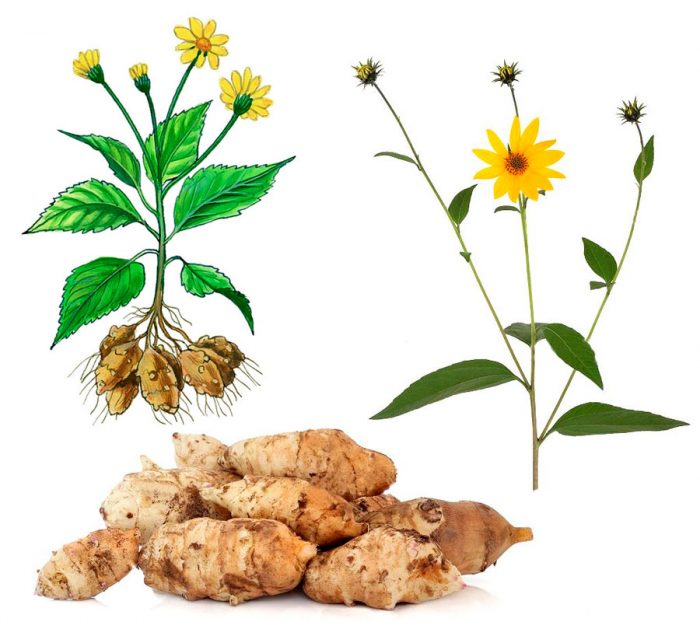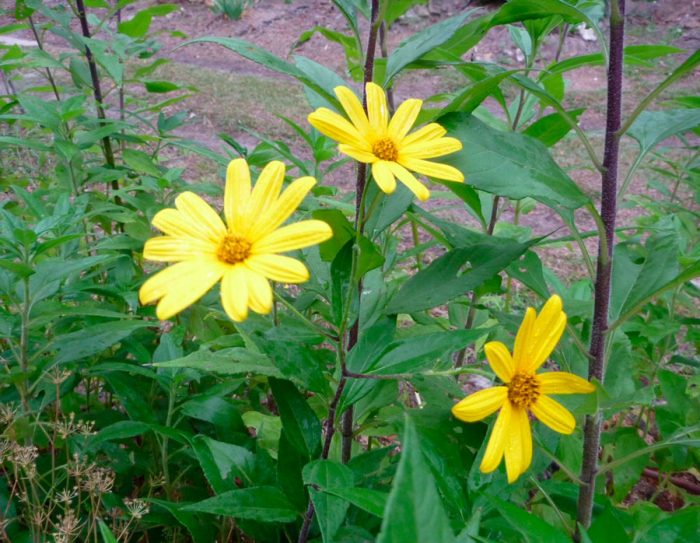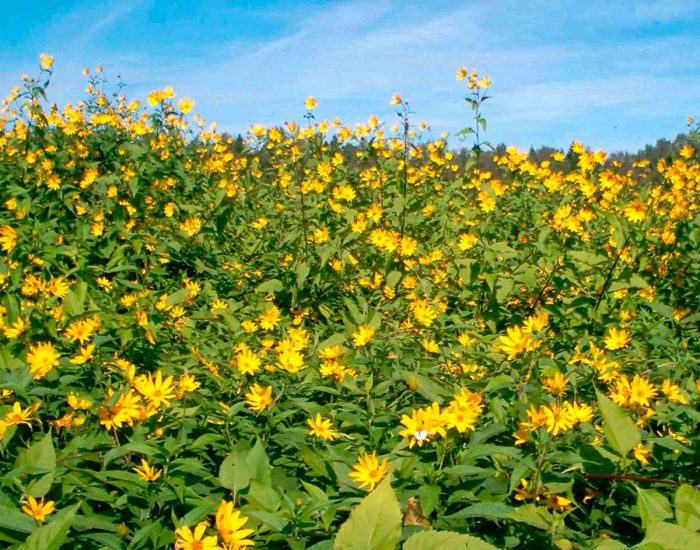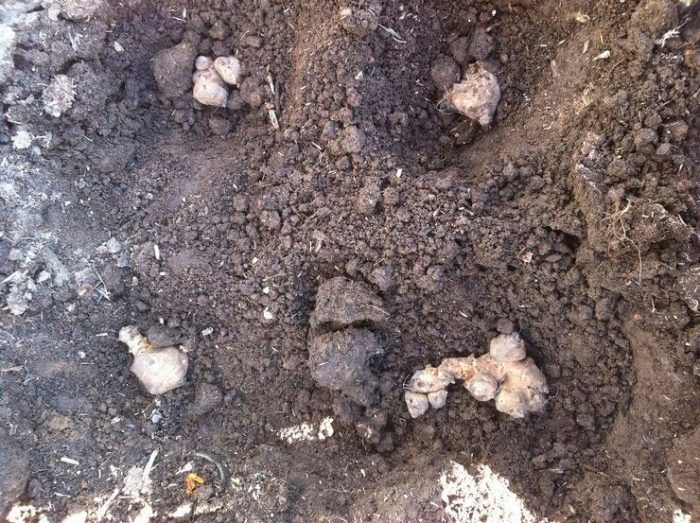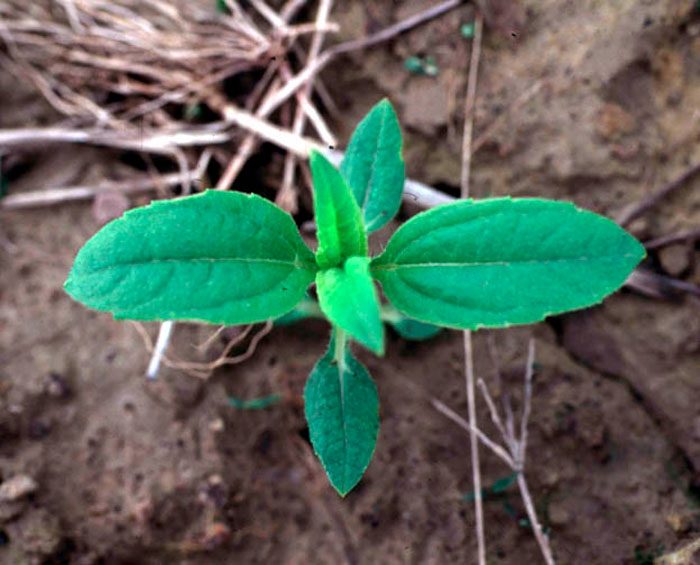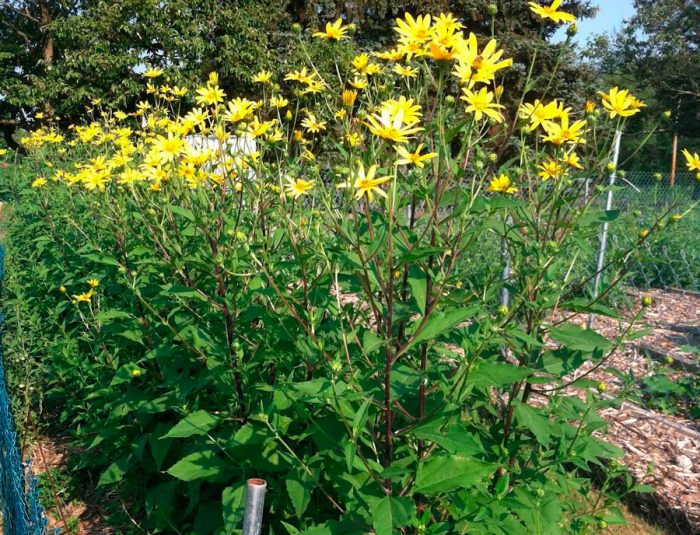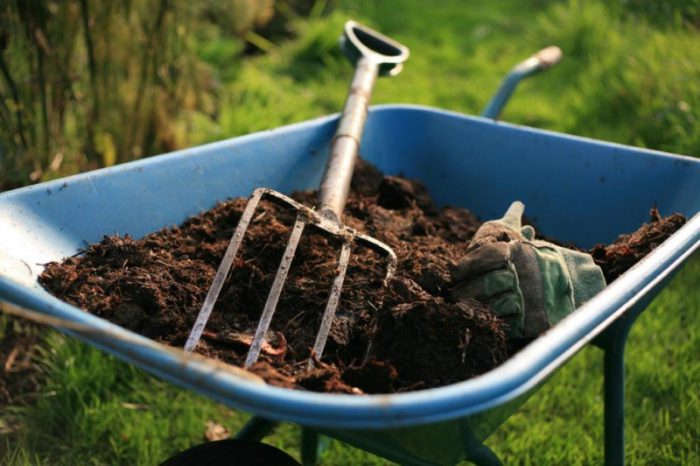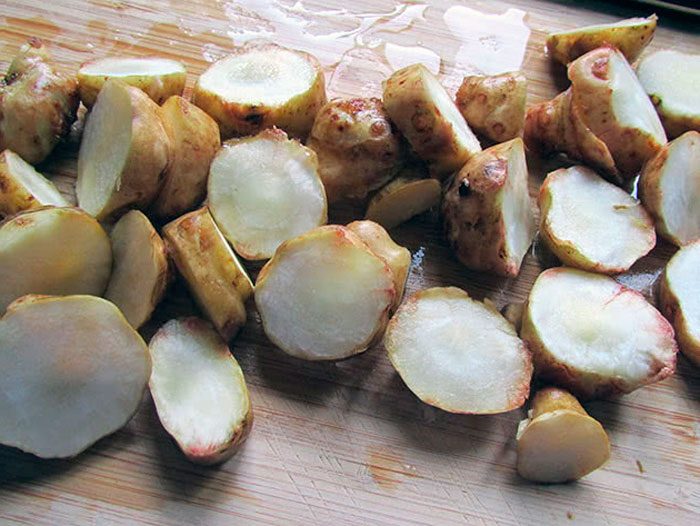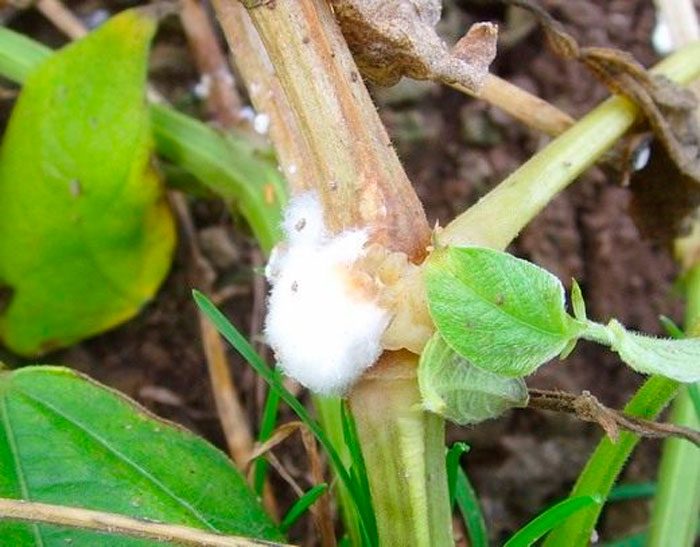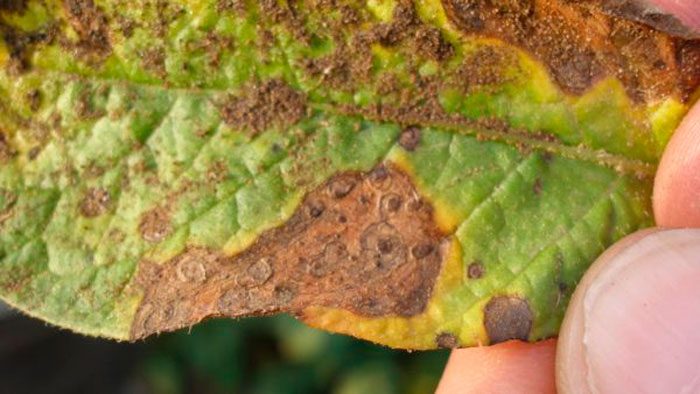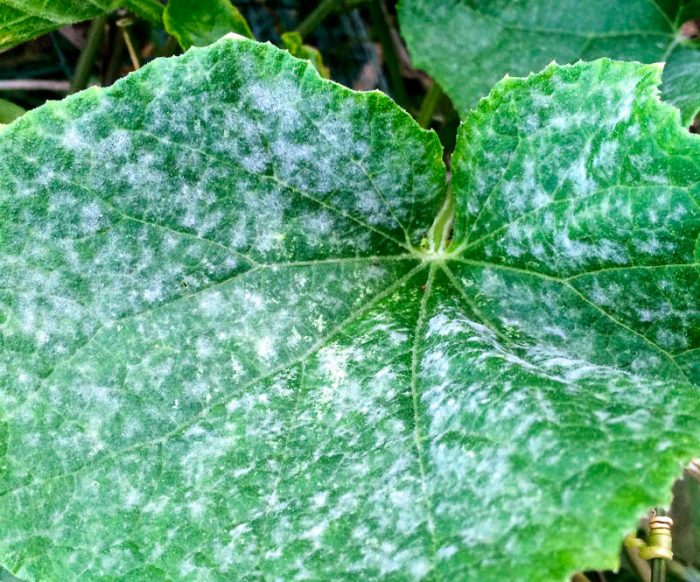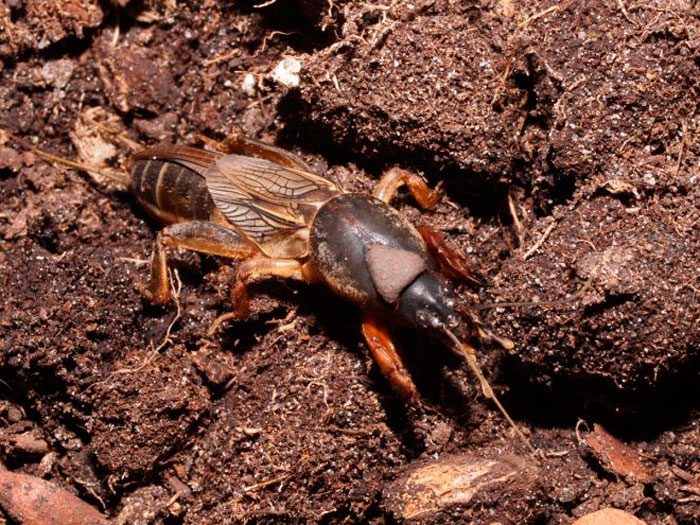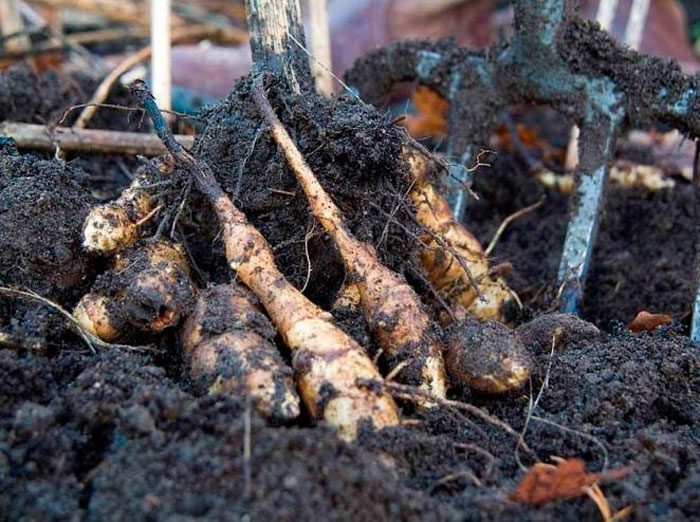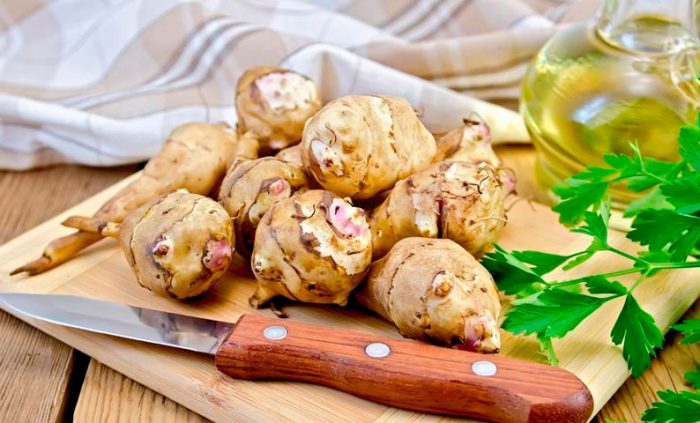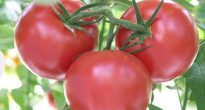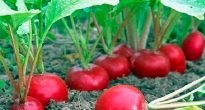The herbaceous plant Jerusalem artichoke (Helianthus tuberosus), also called tuberous sunflower, is considered a representative of the genus Sunflower of the Astrovye family. Also, this plant is popularly called the Jerusalem artichoke, bulb, earthen pear or drumstick. Jerusalem artichoke comes from the name of the Indian tribe Tupinamoas, who lived in the territory where modern Brazil is located today. Such a plant was brought to European countries through France and England in the 16th century, and it was widely cultivated as a food and fodder crop from the middle of the 19th century. Under natural conditions, such a culture can be found in North America in wastelands and along roads. And Jerusalem artichoke is cultivated in almost all countries, while in some of them (for example, in Switzerland, Japan and Australia) it is considered a weed, since it is frost-resistant, unpretentious, fruitful, and such a plant can quickly adapt to any conditions ...
Content
- 1 Brief description of cultivation
- 2 Features of Jerusalem artichoke
- 3 Planting Jerusalem artichoke in open ground
- 4 Jerusalem artichoke care
- 5 Jerusalem artichoke pests and diseases
- 6 Jerusalem artichoke cleaning and storage
- 7 Jerusalem artichoke varieties
- 8 Jerusalem artichoke properties: harm and benefit
Brief description of cultivation
- Landing... Tubers are planted in open soil before winter 15–20 days before the first frost.
- Illumination... The site must be well lit.
- Priming. The soil can be any, as long as it is neutral or slightly alkaline (pH 6.0–7.5), but it should not be too heavy, and salt marshes are not suitable.
- Watering... The plant needs watering only during a prolonged dry period. For 1 bush, 1–1.5 buckets of water are taken.
- Fertilizer... Every year in the spring, mineral fertilizers are applied to the soil, and organic matter is applied once every 2 or 3 years in the autumn weeks.
- Reproduction... Most often, whole or cut tubers with eyes. More rarely, the generative (seed) method is used.
- Harmful insects... Slugs, bears, wireworms.
- Diseases... White rot, Alternaria or powdery mildew.
Features of Jerusalem artichoke
Jerusalem artichoke has a powerful root system, the formation of tubers that can be eaten takes place on their underground stolons. The color of the tubers can be red, white, yellow or purple, outwardly they are similar to the ginger root, and their taste is similar to turnip or cabbage stump.On the surface of the straight and powerful stem, there is pubescence represented by short villi, its height can vary from 0.4 to 3 meters, and in the upper part it branches. Serrated-toothed leaf plates have petioles, and there is pubescence on their surface. The upper leaves are alternately located, their shape is oblong-ovate or lanceolate, and the lower ones are heart-ovoid, oppositely positioned. Inflorescences-baskets in diameter reach 10 centimeters, they include tubular median bisexual yellow flowers, as well as 10-15 pseudo-lingual marginal sterile flowers of golden yellow color. The fruit is a seed that ripens in August – September.
On an industrial scale, this crop is grown in Russia, America and Asia. However, gardeners have been growing Jerusalem artichoke for many decades as a food product that has medicinal properties. The chemical composition of Jerusalem artichoke tubers is very similar to potatoes, and its nutritional value is even higher than that of beets. Such tubers are eaten both raw and boiled, fried and stewed. They are also used to make tea and compote.
Planting Jerusalem artichoke in open ground
What time to plant
Jerusalem artichoke can be grown in a container and in open soil. The tubers are planted in open soil before winter 15–20 days before persistent frosts set in. This can be done in the spring, after the soil warms up well. For podzimny planting, whole tubers are used, and in the spring, if necessary, they are divided into several parts.
To plant Jerusalem artichoke, you should choose a sunny area, while you need to find a place where vigorous bushes, the height of which is about 300 centimeters, will not shade other crops. Experienced gardeners plant bushes along the fence or along the perimeter of the site.
Suitable soil
Jerusalem artichoke grows best in neutral or slightly alkaline soil, while the pH should be 6.0-7.5. It is not picky about the composition of the soil, so it can be grown on almost any soil. However, such a plant cannot be grown on salt marshes and also on excessively heavy soil. The preparation of the site for planting before winter is done 15–20 days before planting the tubers. If the planting will be carried out in the spring, then the preparation of the site must also be dealt with in the fall. Digging the soil is carried out to the depth of a shovel bayonet, while compost must be added to it. If the planting is planned for the spring, then the clods of soil are not broken during digging. This must be done at the end of the winter period. During planting, potash-phosphorus fertilizer is applied to the soil. Then you can start planting Jerusalem artichoke. It is best to plant such a crop in an area where cabbage, potatoes and cucumbers previously grew.
Landing rules
In the last days of April or the first days of May, you need to select small neat tubers the size of a chicken egg. They must be soaked in Epin's solution (1 milligram per 1 liter of water), after which they are planted, keeping a distance of 0.4 m, while the depth of the trench should be from 12 to 15 centimeters, and the width between the rows - from 0.6 to 0.7 m. The soil taken out of the trench must be combined with bone meal, then this soil mixture is poured into the groove.
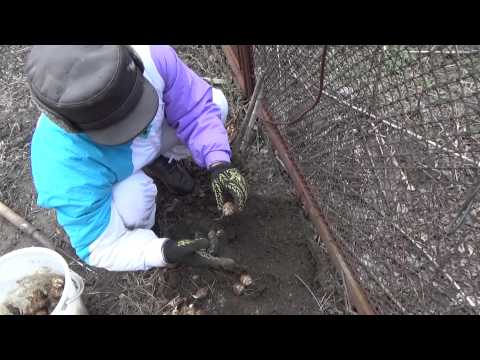

Watch this video on YouTube
Jerusalem artichoke care
When growing Jerusalem artichoke, it is very easy to care for it. After planting the tubers, the site must be weeded out in a timely manner, as well as its surface must be loosened. After the seedlings reach a height of 0.3 meters, they will need hilling with garden compost. This procedure is carried out as needed throughout the growing season.And when the height of the stems is 100 cm, you need to dig in columns from both ends of the row, then between them you need to pull a wire in a plastic winding, it is placed horizontally. Then a garter of bushes is carried out to it, this will save them from injury by gusts of wind. After the formation of buds begins, they must be cut off, as a result, the plant will not expend energy on flowering and the formation of fruits. For the same purpose, the bushes must be shortened to 150-200 cm.
Watering
Plants should be watered only during a prolonged dry period, with 1 to 1.5 buckets of water per plant. If it rains regularly in the summer, then there is no need to water the Jerusalem artichoke at all.
Fertilizer
When cultivating such a plant on your site, fertilizers must be applied to the soil. In spring, when loosening a site, a granular fertilizer is introduced into the soil, which includes potassium and nitrogen. During the formation of buds for feeding, it is recommended to use a liquid fertilizer. In the middle of the summer period, for example, it is recommended to feed with green manure infusion or seaweed solution. Every year, mineral fertilizers should be applied to the soil, while organic fertilizing is carried out 1 time in 2 or 3 years.
Jerusalem artichoke propagation
Among gardeners, the most popular is the vegetative method of reproduction: tubers, their eyes and parts. This is described in more detail above. It is also possible to grow this culture from seeds, but seed reproduction takes a lot of time and effort, and special knowledge is required.
Jerusalem artichoke at home
Large containers or boxes with drainage are used for landing. It is necessary to grow such a culture in indoor conditions in the same way as in open soil. But in this case, Jerusalem artichoke needs to be watered systematically.
Jerusalem artichoke pests and diseases
Jerusalem artichoke diseases
Jerusalem artichoke is highly resistant to disease. But sometimes he can be struck by Alternaria, white rot or powdery mildew.
White rot
Sclerotinosis (white rot) - because of it, a felt moldy bloom forms on the shoots, because of this, the bushes get sick and as the disease develops from the inside, they are covered with black growths. The defeat of plants occurs through the soil. White rot actively develops at high air humidity and sudden temperature changes. All affected bushes must be removed from the soil and destroyed.
Alternaria
Alternaria - this disease is widespread, it contributes to the defeat of all aerial parts of the bush. On the leaf blades, dark or light brown spots are formed with a pale yellow edging. Over time, the growth of spots is observed between the veins of the foliage, while the leaf plates dry out along with the petioles. To get rid of such a disease, the bushes must be sprayed with fungicidal preparations, while the treatment should be carried out at a temperature above 18 degrees. In some cases, one treatment is enough, but it is better to spray the plants again after 10-12 days.
Powdery mildew
Powdery mildew - the defeat of Jerusalem artichoke occurs in the second half of the growing season, while a loose white bloom appears on the front surface of the leaf plates. As the disease progresses, the plaque changes its color to brown or pale pink, and the affected foliage becomes brittle and fragile. The disease develops actively in hot weather with sharp changes in temperature and humidity, and also due to the high nitrogen content. The disease can be cured by spraying the bushes with a solution of a fungicidal preparation, for example, Bayleton, Skor, But, Topaz, Quadris, Tilt, Topsin and similar agents.
Jerusalem artichoke pests
The culture can be damaged by bears, slugs and the larvae of some insects.In order to ensure the protection of Jerusalem artichoke from slugs, special anti-slug granules should be spread over the surface of the site.
If such harmful insects as May beetles, scoops or bears are seen on the site, then before planting Jerusalem artichoke in the soil, they dig it up and introduce Foxim or Diazonon.
Jerusalem artichoke cleaning and storage
Duration of ripening of Jerusalem artichoke tubers is not less than 120 days. It is not necessary to dig them out ahead of time, since in this case they will not have time to ripen to the required quality. It is necessary to extract the tubers in the spring after the soil warms up well, or in the fall after the soil begins to freeze. Tubers, being in open soil, can safely withstand a drop in air temperature to minus 40 degrees, but for the winter the site should be covered with a layer of snow or dry soil. Gardeners usually dig up such a number of tubers in the autumn, which is enough for the whole winter, while the rest are removed from the ground in the spring (they will not be superfluous during the period of vitamin deficiency). However, they must be removed before the warm weather sets in, otherwise the tubers will grow, and they will lose their taste and benefits, while Jerusalem artichoke will become just a weed.
The tubers should be stored in the same way as other root crops; for this they are placed in boxes and sprinkled with sand. Before you put Jerusalem artichoke in storage in the cellar, they must be rinsed and wait until they dry thoroughly. Boxes with Jerusalem artichoke can also be stored on an insulated balcony or loggia. If tubers are scarce, they can be stored on the vegetable shelf in the refrigerator.


Watch this video on YouTube
Jerusalem artichoke varieties
To date, breeders are trying to develop such varieties of Jerusalem artichoke, in which the tubers in the soil will be placed compactly, since the root system with formed nodules is capable of growing in breadth and depth. Breeders already have some success. They are also working on breeding such a fodder variety in which the thickness of the shoots will be greater than usual. They are also working on breeding zoned varieties.
The varieties available today are divided into tuberous and fodder. In fodder varieties of tubers, not very much is formed, but a rich harvest of green mass is growing. These varieties are used for growing on an industrial scale. Still all fodder and tuberous varieties are divided into early and late ripening periods. The best varieties of Jerusalem artichoke will be described below:
- Interest... This late, fast-growing variety is distinguished by its productivity, moisture demand, and also resistance to heat and frost. Erect, strong shoots of medium branching are decorated with rough large leaf plates of a dark green color. Smooth white tubers have deep eyes. It is used for industrial cultivation in regions with warm climates.
- Leningradsky... This late variety has a high yield. The plant has a bushy shape and dark green shoots. Green leaf plates are oval in shape. Elongated white tubers are of medium size. They keep well in the soil until the onset of winter. This variety can be cultivated in the northwest region.
- Volzhsky 2... This vigorous variety is resistant to drought and frost. The bushes have a compact root system and rounded shoots. The surface of the green leaf plates is slightly pubescent. White pear-shaped tubers have pale purple fragments.
- Skorospelka... This early variety is characterized by undemanding lighting and frost resistance. Its root system is compact. Strongly branched shoots have heart-shaped leaf plates, which are indented along the edge with large teeth. White smooth tubers have a rounded shape.
- Pasko... Late tuberous bushy variety has a high yield. Vigorous bushes consist of weakly branching shoots, large leaf plates and rounded white tubers that weigh about 80 grams.
- Solar... Such a late-ripening tuber variety has a high yield, it can be cultivated in any region. Moderately bushy plants have highly branched shoots and large leaf plates. Medium-sized white tubers have an elongated elliptical shape and weigh about 60 grams.
- Find... A late variety with a high yield. On weakly branched shoots, large leaf plates are asymmetrically placed. The root system is compact, pear-shaped white tubers near the eyes have pink veins. The variety is intended for cultivation in the southern regions.
Among gardeners, the following varieties of Jerusalem artichoke are very popular: White, Patat, Fusiform, Vadim, Red, Omsk White and North Caucasian.
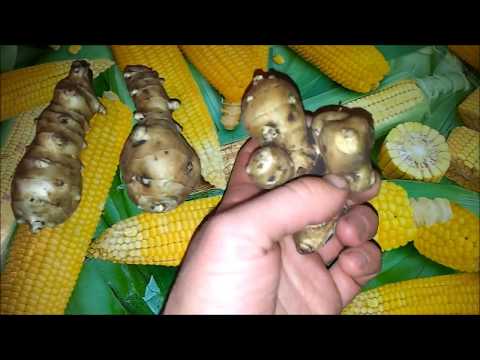

Watch this video on YouTube
Jerusalem artichoke properties: harm and benefit
The healing properties of Jerusalem artichoke
Jerusalem artichoke contains a large amount of various vitamins and minerals. The tubers contain more iron than turnips, carrots and beets, while 1 kilogram of Jerusalem artichoke contains 60 to 70 milligrams of carotene. Jerusalem artichoke contains potassium and calcium, chromium and fluorine, magnesium and manganese, silicon and sodium, vitamins B1, B2, B6, B7, C, PP, as well as fiber, pectin, fats, proteins, organic acids, a natural analogue of insulin inulin and amino acids arginine, valine, leicine and lysine.
This herb can help with urolithiasis, salt deposits, anemia, gout and obesity. A decoction is prepared from Jerusalem artichoke, which helps to normalize the activity of the pancreas, and even lower the sugar level. Experts recommend that residents of large cities with an unfavorable ecological situation include Jerusalem artichoke tubers in their diet, since they contain inulin and fiber, which help cleanse the human body of radionuclides, heavy metal salts, excess cholesterol and toxins. Experts advise including tubers of such a plant in your diet in the following situations:
- with various diseases of the gastrointestinal tract;
- to cleanse the body of toxins;
- to protect against viral infections;
- for the prevention of diabetes mellitus;
- to lower blood pressure;
- to increase the level of hemoglobin in the blood.
This plant contains more carbohydrates than beets and sugar cane. Jerusalem artichoke tubers have the greatest benefit immediately after harvesting because during long-term storage, a certain part of insulin becomes fructose as a result of hydrolysis. But this does not mean that tubers become harmful, especially for patients with diabetes mellitus, since they use fructose instead of sugar.
Such a culture can eliminate nausea, stop vomiting, and it also helps to eliminate the bitter taste in the mouth and neutralize increased acidity. Also, such tubers can be included in the diet of pregnant women, because they enrich the body of the fetus and mother with useful substances. If, during the drug treatment of various diseases, you regularly eat the tubers of such a plant, then as a result of recovery, it will go much faster, this is due to the fact that Jerusalem artichoke helps to strengthen the immune system, as well as cleanse the body of toxins. If you regularly drink the juice of such a plant, it will help to reduce the increased acidity of gastric juice, eliminate headaches associated with high blood pressure, and it also helps to heal ulcers and wounds faster, and helps to alleviate the condition in diseases of the duodenum and stomach, and with polyarthritis ...Freshly squeezed Jerusalem artichoke juice should be taken three times a day, 15 milligrams each, a quarter of an hour before a meal.
Such a culture is also widely used in cosmetology. Jerusalem artichoke helps to eliminate irritation or inflammation of the skin, and also helps to cleanse pores and smooth wrinkles. To eliminate the laxity of the skin, the neck and face must be wiped overnight with the juice of this plant. For the treatment of oily skin, a mask is used, for the preparation of which a topinambur tuber crushed on a grater is used with the addition of ½ tsp. honey. The same mask, the composition of which is described above, nourishes dry skin of the face, but it must be mixed with ½ tsp. olive oil. After a third of an hour, the face should be washed with lukewarm green tea, and after another 10 minutes. rub it with an ice cube. The cosmetic course includes 20 procedures.


Watch this video on YouTube
Contraindications
This culture has no contraindications. However, it should not be used in case of individual intolerance. If the tubers are eaten raw, then this can contribute to the development of flatulence, but after a while the intestines will get used to it. There are cases when such addiction does not occur, then experts advise whether there are boiled or stewed tubers. You also need to remember that you cannot eat a large amount of Jerusalem artichoke at a time.

